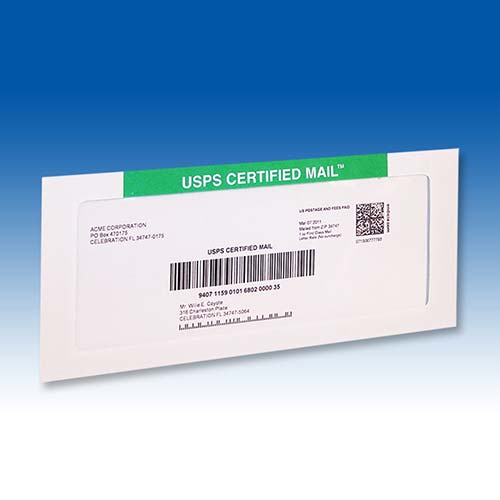
Certified Mail® is a great way to ensure the safety and validity of the mail you're sending, but what is Certified Mail, exactly?
Since it was first set up in 1775, businesses of all sizes have relied on the US mail service to keep their operations running smoothly and to send and receive secure payments.
With this in mind, the Postal Service first offered Registered Mail in 1855. The aim was to ensure certain added security measures when sending specific items.
However, it wasn't until 1955 that the US mail service offered Certified Mail as an alternative mailing option.
But what is it? Here we explain everything you need to know about Certified Mail, including all the options available to you when using this service.
What Does It Mean?
Certified Mail is a domestic mail service. It provides added security by allotting a unique tracking number to each article mailed.
With the Certified Mail service, the sender receives a mailing receipt as legally-recognized proof of sending. The recipient must also sign for certified mail as a way to prove that the mailed item has been delivered.
You can purchase the Certified Mail service for First-Class Mail, First-Class Package Service or Priority Mail. These different services determine how soon your mailed article will arrive.
Unlike with the Registered Mail service, you cannot purchase insurance for items sent via Certified Mail.
How Does It Work?
Each Certified Mail article is scanned and tracked by the United States Postal Service (USPS) tracking system.
The mail item is first scanned when it is accepted into the mail stream at the Post Office. It is then tracked as it makes its way through the various USPS mail sorting and automated processing centers.
Finally, the Postal worker responsible for delivering your item must scan and track the recipient's signature, as required upon delivery.
Once the recipient receives and signs for the item, the recipient's signature is kept on file for two years as proof of delivery.
Do You Have to Sign for It?
In a word, yes. If no one is at home to accept or sign for an item delivered by Certified Mail then the Postal worker responsible cannot deliver it.
If you are the recipient and refuse to sign for the item then the Postal worker cannot give it to you.
Even if the sender has not requested a Return Receipt Signature, Certified Mail requires signed proof that the mail item has been delivered.
If the item is not delivered and no one picks the letter up from the local Post Office, USPS will return the mail item to the sender.
Delivery Options
As the sender, you can receive a copy of the recipient's signature when you send the item by purchasing an added receipt service. Here are the different options when it comes to choosing your Certified Mail service:
Certified Mail
This provides a unique tracking number which you can then check online to confirm that your item arrived at its destination.
The Postal worker can deliver your Certified Mail item to anyone who receives mail at the given address. This can mean that the confirmation signature is not necessarily that of the intended recipient.
Return Receipt
For an extra fee, a return receipt, or 'green card', is attached to the mail item. The recipient must sign and date the green card when they receive the mail item. As the sender, you will then receive the green card via mail.
Electronic Return Receipt
For an extra fee, the Postal worker responsible for delivery can create an electronic version of the Return Receipt green card as a PDF document. This receipt includes an image of the recipient's signature or an approved hand-stamp.
Return Receipt and Restricted Delivery
This is the strictest of the Certified Mail options. Adding the restricted delivery service to the return receipt ensures that the Postal worker must deliver it directly to the recipient, or an authorized agent.
Return Receipt After Mailing Service
If you don't purchase a Return Receipt at the point of sending you can purchase the Return Receipt After Mailing service up to two years after sending your item.
Who Uses It?
Because of the added security of Certified Mail, law firms and government agencies often use this service.
It is particularly useful when they need a legally-recognized proof of delivery. This could be when sending court papers, important contracts, or tax audit notifications.
In the case of using the restricted delivery service, this guarantees that the addressee has received the mail item in their hands.
And, the signature operates as a type of receipt which the sender can access up to two years later. This is often useful in cases where the recipient denies receiving the mail item.
An Easier Way
Although Certified Mail is a great service, there is a way to take advantage of the added security it offers while skipping the line at the Post Office.
You can do this by printing Certified Mail Labels to apply to the envelope you wish to send by Certified Mail. Then you can send it by placing it in any one of the thousands of post boxes across the US.
You can buy approved USPS Certified Mail envelopes and print the recipient's details straight onto them, ready for postage.
All Certified Mail services are available through this easier method, and you can save money on them too. By purchasing online and using automation to replace green cards, you can save as much as $3.45 per mailing.
Get Started Today
Thanks to this guide, you should know all the facts you need to answer the question, 'What is Certified Mail?'
And, with the added possibility of sending mail with Certified Mail Labels, you can benefit from the combination of extra security and convenience.
Schedule a FREE Live Demo to learn more today!

